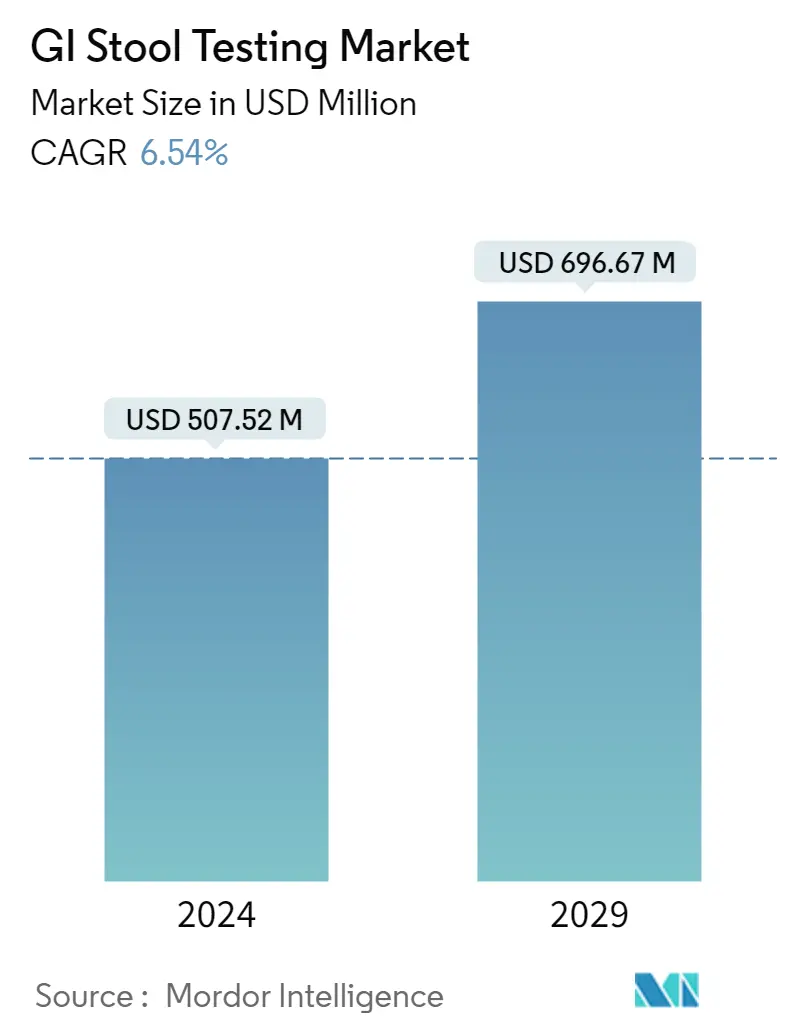Market Size of GI Stool Testing Industry

| Study Period | 2019 - 2029 |
| Market Size (2024) | USD 507.52 Million |
| Market Size (2029) | USD 696.67 Million |
| CAGR (2024 - 2029) | 6.54 % |
| Fastest Growing Market | Asia Pacific |
| Largest Market | North America |
Major Players
*Disclaimer: Major Players sorted in no particular order |
Need a report that reflects how COVID-19 has impacted this market and its growth?
GI Stool Testing Market Analysis
The GI Stool Testing Market size is estimated at USD 507.52 million in 2024, and is expected to reach USD 696.67 million by 2029, growing at a CAGR of 6.54% during the forecast period (2024-2029).
- COVID-19 affected the GI stool testing market significantly. Various clinical studies were conducted to confirm the presence of coronavirus among the population. For instance, an article published in Frontiers in Medicine in May 2021 showed that Cepheid Xpert Xpress SARS-CoV-2 (tests with three gene targets (E, N2, and RdRP) assay was used for the accurate identification of viral RNA in stool samples. In addition, the Xpert Xpress SARS-CoV-2 test uses the GeneXpert benchtop equipment to enable qualitative detection of the virus in about 45 minutes.
- The inclusion of stool PCR in the testing algorithm was anticipated to increase clinical sensitivity. Furthermore, as per the same source, the detection of viral RNA in stool was confirmed after 33 days, and stool PCR confirmed the diagnosis of SARS-CoV-2 in two individuals whose upper respiratory tract PCR results were negative. This has increased the utilization of stool testing techniques for confirming COVID-19 infection among the population, which is further anticipated to fuel the market growth over the forecast period. However, currently, as COVID-19 cases have been subsidized, the rising application of Gi stool testing leads to the stable growth of the market over the coming years.
- The factors such as the growing burden of gastrointestinal diseases and rising preference for point-of-care tests are boosting the market growth. For instance, a 2022 update by Bower Cancer UK showed that bowel cancer is the 4th most common cancer, and approximately 43,000 people are diagnosed with bowel cancer every year in the United Kingdom. This is expected to increase the demand for stool DNA testing, which is used to screen for colon cancer in people with no symptoms, hence propelling the market growth.
- Additionally, as per an article published in PLOS One in April 2021, it has been observed that the overall prevalence of hemorrhoids was higher in the male population in Northwest Ethiopia. The risk of having hemorrhoids was shown to be higher in people who were overweight and had constipation problems. Thus, the high prevalence of hemorrhoids among the population is anticipated to increase the need for a fecal occult blood test to early detect the disease and hence boost the market growth.
- Furthermore, the rising product launches increase the availability of stool testing kits and products in the market, which in turn is anticipated to fuel the market growth. For instance, in June 2022, Prenetics Group Limited, one of the global leaders in genomic and diagnostic testing, launched a novel, non-invasive, at-home screening test, ColoClear by Circle (ColoClear), for detecting early signs of colorectal cancer in Hong Kong.
- Therefore, owing to the factors such as the high burden of gastric cancer and other related diseases, the studied market is expected to grow over the forecast period. However, the high cost of instruments is expected to impede the growth of the GI stool testing market over the forecast period.
